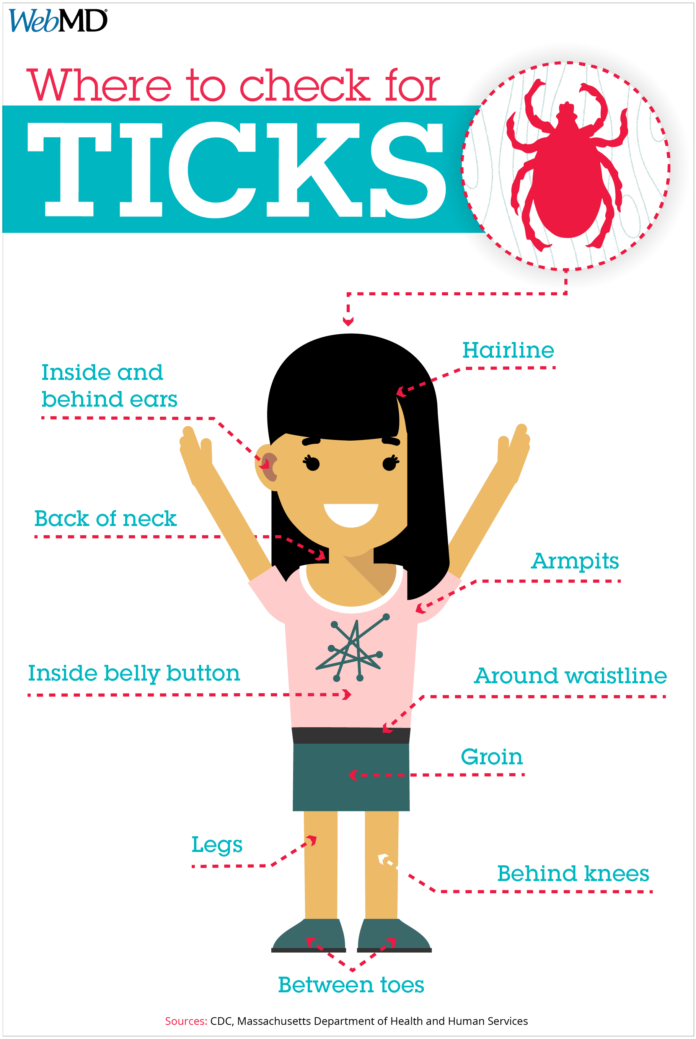Early signs and symptoms of Lyme disease can be very mild and potentially missed. The disease may resemble the flu at its onset. Its most distinct symptom is a bull's-eye-shaped rash. But in at least one-quarter of Lyme disease patients, the telltale rash does not develop, notes the National Institute of Allergy and Infectious Diseases (NIAID). (1)
Causes and Risk Factors of Lyme Disease
Lyme disease is caused by the bacterium Borrelia burgdorferi and, rarely, Borrelia mayonii. Humans can get Lyme disease if they are bitten by an infected blacklegged tick, according to the CDC. (5)
Usually the deer tick must be attached for 36 to 48 hours to transmit Lyme disease, notes the Mayo Clinic. (6)
Not all ticks carry Lyme disease, and some ticks carry other diseases.
A person’s chances of getting bitten by a tick and getting Lyme disease can depend on where they live, travel or what they do for a living. Common risk factors for contracting Lyme disease include the following: (6)
- Spending a lot of time in wooded or grassy areas, especially in the Northeast and Midwest United States
- Exposed skin, which can make it easier for ticks to attach or bite you
- Removing ticks incorrectly or removing them 36 hours or more after they’ve attached to your skin which allows the bacteria from the bite to enter your skin
How Is Lyme Disease Diagnosed?
Your doctor can make a preliminary diagnosis of Lyme disease based on your symptoms and history of exposure to blacklegged ticks.
It's very likely that you have Lyme disease if you:
- Live in an area where blacklegged ticks are common
- Have a bull's-eye-shaped erythema migrans rash
- Have other common Lyme disease symptoms, in addition to a rash
Your doctor may confirm your diagnosis with laboratory blood tests or may conduct these tests if you don't meet all the above criteria. But these tests are often not done right away or else they are less reliable and may result in a false-negative. If a patient's symptoms and history suggest that Lyme disease is likely, the doctor will probably begin treatment without waiting for a blood test.
The CDC recommends a two-step process for testing blood for the antibodies against Lyme disease: the enzyme immunoassay (EIA) or indirect immunofluorescence assay (IFA), followed by an immunoblot test (Western blot) if the first test is positive.
A diagnosis of Lyme disease is made if both the EIA or IFA and the Western blot test are positive, per the CDC. (7) These tests measure antibodies made by the immune system in response to the Lyme infection. However, laboratory testing for Lyme disease can be inaccurate because it can take weeks for an infected patient’s body to create a detectable immune response. If the test is administered before the body develops these antibodies, the results will be negative even if the person has Lyme disease, according to a meta-analysis published in November 2016 in the International Journal of General Medicine. (8)
Prognosis of Lyme Disease
People treated with antibiotics in the early stages of Lyme disease usually make a full recovery. Without treatment there can be complications that involve the joints, heart and nervous system, but these symptoms can still go away with treatment.
Although it is rare, some people develop what’s called post-Lyme disease syndrome. Those individuals still have symptoms of Lyme Disease that interfere with their life even after they’ve been treated, according to MedlinePlus. (2)
Treatment and Medication Options for Lyme Disease
Lyme disease is treated with antibiotics. Typically, the sooner the treatment is started (and completed), the faster the recovery will be.
Medication Options
The standard treatment for adults and children for early-stage Lyme disease is oral antibiotics. (6)
- Doxycycline can be used for adults and children older than 8.
- Amoxicillin or cefuroxime is recommended for adults, younger children, and pregnant or breastfeeding women.
If Lyme disease progresses to a more advanced stage and involves the nervous system, intravenous antibiotics may be needed. These are usually prescribed for 14 to 28 days and will eliminate the infection, though they can cause side effects, including a lower white blood cell count, mild to severe diarrhea, or colonization or infection with other antibiotic-resistant organisms unrelated to Lyme. (6)
Alternative and Complementary Therapies
There are no proven treatments for Lyme disease other than antibiotics. There are alternative or complementary treatments that are marketed to people with Lyme disease, but there isn’t scientific evidence to prove they work or are even safe to use. (6)
Bismacine, also known as chromacine, is an alternative medicine that some people try for Lyme disease. The U.S. Food and Drug Administration (FDA) has cautioned against using this injectable product which has reportedly caused hospitalization and at least one death. (10)
If you’re considering an alternative or complementary treatment for Lyme disease, it’s important to talk with your doctor first.
Learn More About Treatment for Lyme Disease: Medication, Alternative and Complementary Therapies, Surgery Options and More
Prevention of Lyme Disease
There currently isn’t a vaccine to protect against Lyme disease. Per the FDA, the following precautions can help reduce your chances of getting a tick bite: (11)
- Avoid woody, brushy and grassy areas, especially in May, June, and July.
- Wear light-colored clothes so that you can spot a tick if it gets on you.
- Wear long pants and long-sleeved shirts and shoes that cover your whole foot (no sandals)
- Tuck your pant legs into socks or shoes and tuck your shirts into your pants.
- Wear a hat to protect your head.
- Spray insect repellant containing DEET on clothes and areas of uncovered skin.
- If you’re on a trail, walk in the center to avoid brush and grass.
- Take off your clothes right away when you come in from the outdoors and wash and dry them at high temperatures.
- Carefully check your body and head for ticks after outdoor activities.
Research and Statistics: Who Can Get Lyme Disease?
Anyone can get a tick bite. People who spend time outdoors such as campers, hikers, and people who work in gardens and other leafy outdoor venues are at the highest risk. (11)
Between 2004 and 2016, the number of disease cases from ticks have doubled, per the CDC. (12) In 2018, there were 33,666 reported cases of Lyme disease, down from 42,743 cases in 2017. (13)
The 10 states with the highest reported number of tick related diseases were Pennsylvania, New York, New Jersey, Massachusetts, Connecticut, Wisconsin, Minnesota, Maryland, Virginia and New Hampshire. (12)
Related Conditions and Causes of Lyme Disease
Although Lyme disease is by far the most common tickborne disease in the United States, there are others.
Anaplasmosis and ehrlichiosis are caused by tick bites and can affect people of any age. Symptoms can include fever, muscle aches, weakness, and headache. Tetracycline antibiotics usually cure the diseases quickly, notes the New York State Department of Health. (18)
Spotted fever rickettsioses are a group of diseases spread by infected ticks and mites. The illnesses these infections can cause can range from mild to life-threatening, and symptoms include fever, headache and rash. The antibiotic doxycycline is usually used to treat spotted fever infections, notes the CDC. (19)
Babesiosis is a rare disease caused by the bite of a tick infected with Babesia microti, a tiny parasite that infects red blood cells. Many people who get this infection don’t have any symptoms, while others have flu-like symptoms such as fever, chills, and body aches. A blood test can be done to confirm the infection. If babesiosis requires treatment (it doesn’t always), antibiotics are used. It’s possible to be infected with Lyme disease and babesiosis at the same time, notes the New York State Department of Health. (20)
Resources We Love
To find out more information about how Lyme disease is diagnosed and treated, as well as tips on prevention, check out the following resources:
American Lyme Disease Foundation (ALDF)
This organization is dedicated to preventing, diagnosing and treating Lyme disease.
LymeDisease.org
The mission of this group is to empower people with Lyme disease with providing education and research tools and to advocate for legislative change.
National Library of Medicine (Lyme Disease)
The Medline Plus encyclopedia offers medically reviewed information on the causes and treatment of Lyme disease.
Lyme Disease Support Network
This online community helps connect people with Lyme disease as well as their caregivers. Message boards allow people to share information and experiences about living with the disease.
Additional reporting by Becky Upham.


Editorial Sources and Fact-Checking
- Lyme Disease Diagnostics Research. National Institute of Allergy and Infectious Diseases. September 28, 2016.
- Lyme Disease. MedLine Plus. November 3, 2020.
- Steere A, Coburn J, Glickstein L. The Emergence of Lyme Disease. Journal of Clinical Investigation. April 15, 2004.
- Lyme Disease Rashes and Look-Alikes. Centers for Disease Control and Prevention. September 4, 2015.
- Lyme Disease. Centers for Disease Control and Prevention. December 16, 2019.
- Lyme Disease. Mayo Clinic. July 13, 2019.
- Two-Step Laboratory Testing Process. Centers for Disease Control and Prevention. March 26, 2015.
- Cook MJ, Purl BK. Commercial Test Kits for Detection of Lyme Borreliosis: A Meta-Analysis of Test Accuracy. International Journal of General Medicine. November 18, 2016.
- Stages of Lyme Disease. Michigan Medicine. January 26, 2020.
- Lyme Disease. Penn State Hershey – Milton S. Hershey Medical Center.
- Ticks and Lyme Disease: Symptoms, Treatment, and Prevention. U.S. Food and Drug Administration. May 24, 2018.
- Illness on the Rise. Centers for Disease Control and Prevention. May 1, 2018.
- Tickborne Disease Surveillance Data Summary. Centers for Disease Control and Prevention. November 4, 2019.
- Springer YP, Johnson PTJ. Large-Scale Health Disparities Associated With Lyme Disease and Human Monocytic Chrlichiosis in the United States, 2007-2013. PLoS One. September 27, 2018.
- Dennison R, Novak C, Rebman A, et al. Lyme Disease With Erythema Migrans and Seventh Nerve Palsy in an African American Man. Cureus. December 11, 2019.
- Labor Force Statistics from the Current Population Survey. U.S. Bureau of Labor Statistics. January 22, 2020.
- Nelson CA. Lyme Disease in Hispanics, United States, 2000-2013. Emerging Infectious Diseases. March 2016.
- Anaplasmosis and Ehrlichiosis: Tick-Borne Bacterial Infections. New York State Department of Health. November 2016.
- Other Spotted Fever Group Rickettsioses. Centers for Disease Control and Prevention. January 18, 2019.
- Babesiosis. New York State Department of Health. July 2017.











































